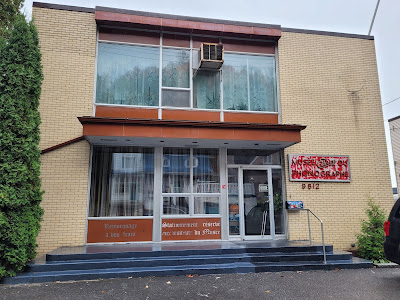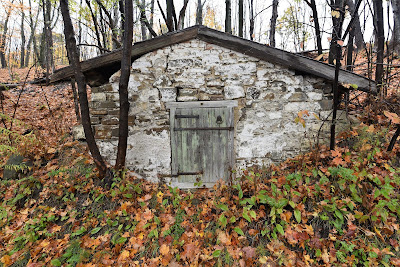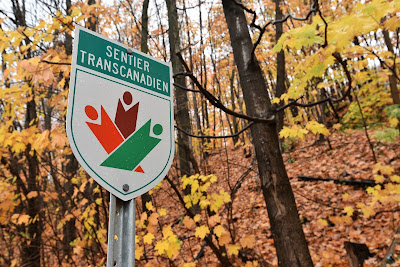Route de la Nouvelle France : Saint-Anne-de-Beaupre to Boischatel
When we woke up this morning the sky was dark and it was pouring rain. As a result, we had a very late start, heading out around 10:00 am in an effort to avoid getting immediately and completely drenched. We were only partially successful, as the rain continued to fall on and off for the next few hours, but at least it was a warm fall day.
Due to the rain we had a relatively short walk today, covering only around 22 km along the Route de la Nouvelle France. This is one of the oldest thoroughfares in North America, connecting the eastern edge of Quebec City to the Côte-de-Beaupré, which is around 57 km east of the capital city. For the first 16 km of the walk we followed the Avenue Royale, and for the last 5 km the TCT diverted onto a paved bicycle trail, which is a continuation of the Marie-Hélène Prémont veloroute.
There are eight major points of historical interest along the Route de la Nouvelle France, and we began at one of them - the Sainte-Anne-de-Beaupré Shrine. From there we walked in the wet, rainy morning through the village of Sainte-Anne-de-Beaupré.
We passed the colourful Galerie d'Art, with its red, blue and white balcony railings, and yellow trim, which is one of the oldest hotels in the town.
A few doors down we passed the Musée Edison du Phonographe, which houses one of the most important collections of cylinder phonographs in North America. This private collection was started in 1970 by Jean-Paul Agnard, and now contains more than 250 phonograph cylinders, all of which are in good working order, as well as 2, 6, and 24 cylinder jukeboxes, and a phonograph alarm clock. The phonograph was invented by Thomas Alva Edison in 1877, and it was the earliest medium for recording and replaying sound. The museum includes recordings of the voices of Thomas Edison, Pope Leo XIII, Theodore Roosevelt, Enrico Caruso, Sarah Bernhardt, and other historically important figures. Sadly it was closed when we walked by this morning.
As we headed out of town it was clear almost immediately that our walk today would be rich in history. The route was marked with tall metal crosses that were reminiscent of the way markers along the pilgrimage routes in France. The road was also lined with heritage homes which were marked with historical plaques bearing the names of the families who originally settled there. Many of the homes dated from the mid 1600's or the 1800's.
Over the course of the day we passed through a series of small communities strung out along the road. Some consisted of small developments of more modern homes. Most consisted of very European feeling houses of different styles. Many of the oldest homes were stone with very tall, steep roofs that were styled after the 17th and 18th century homes in Normandy. Others were covered in white stucco, wood, or panelling, and had colourful custom made and hand crafted trim in red, green, or finished wood. Many of these were topped with very tall, curving dormered roofs that created overhangs supported by balconies with intricate hand forged metal or colourful wooden railings. Interestingly, quite a few homes seemed to have pressed tin siding, and many barns and homes had sloping metal or copper roofs.
In addition to the heritage homes, another interesting component of the walk was seeing dozens of brick and stone root cellars tucked into the steep cliff that bordered the road. Many of these small structures resembled hobbit homes, with rounded doors and sloping roofs covered in vegetation. Quite a few bore interpretive plaques indicating their age. Construction of these small structures, whose partially buried walls were built from masonry and lined with lime, became popular in the 17th and 18th centuries as a means of preserving fruits and vegetables through the winter months. The lay of the land in this area was well suited to the construction of root cellars and led to a great many of them being built.
We also spotted a plethora of brick, stone, or clay bread ovens built along the road. These rounded structures, many with roofs over top, were apparently built away from the main houses in order to prevent fires from damaging the family homes. Since the homes must have been heated with wood anyway, it is unclear to me why bread ovens would have posed a particular threat, but it was very interesting to see them along the way.
Most of the day was spent walking along the sidewalks, or on the pavement of the narrow and winding Avenue Royale. The tall escarpment, which was covered in brilliant fall colours rose steeply to our right, and many of the historic buildings were tucked into the base of it, their front doors only a few feet from the road. On the other side of the avenue small farms with historic wooden barns sat in lush green fields that stretched out to the distant highway.
As we progressed along the road, the rain fell softly, setting the reds, oranges, and yellows of the sugar maple leaves aglow. The smell of wood smoke filled the air, joined occasionally by the scent of beeswax, fresh sawdust, maple sugar, or baking. It felt like we'd slowed way down and gone back in time. We were immersed in history, easily able to imagine a different way of life. In contrast, across the fields we could occasionally see the cars and trucks speeding down the highway, which was lined with modern motels, gas stations, convenience stores, and industrial businesses. The contrast between fast and slow, modern and ancient was at the front of out minds.
In one of the historic stone buildings we passed, set in a beautiful little garden, was the Átelier Economusée of Woodcarving. We could see a few of the wooden and fibreglass sculptures that were on display in the landscaped flower garden, and they looked very interesting. The artists who work there seek to give each piece of wood a voice so that the story or legend contained within it is brought to light. Unfortunately it too was closed as we trekked by.
When we reached the village of Château-Richer it was raining quite hard, and we
didn't hesitate to stop in at Chez Marie, which is another point of interest on
the Route de la Nouvelle France. Chez Marie is an artisanal bakery which
is housed in a stone homestead that was built in 1652. It has been run by
the Turgeon family and its descents for 90 years, and out front there is a
fully operational stone bread oven that is 150 years old.
As we stepped through the red wooden door down into the fieldstone bakery we were greeted with a wave of warmth and the delicious smell of freshly baking bread. The small shop offered a selection of local arts and crafts, maple products, jams, and of course artisanal bread. It also featured an enormous collection of badges worn by tour bus drivers that have stopped by the bakery. We bought some treats to send home to my family, and sampled a delicious slice of fresh bread coated in a thick layer of sweet, tasty maple butter. It was the perfect snack to fuel our journey through the rainy morning!
As we continued down the Avenue Royale, which was originally called the Chemin Roi, or the King's Rd, we suddenly heard church bells ringing out through the trees. This was our first clue that we were approaching the town of Château-Richer. This is where the first rural parish in New France was established in 1678, and many of the oldest families in Quebec first settled there.
Soon we saw the twin spires of the Église Château-Richer rising above the homes lining the winding road, and the colourful trees beyond. We soon reached a very steep drive leading up to the church, at the base of which was a Marian cave that was built in 1930. We climbed a long staircase to the top of the hill, where we found the Catholic Church, which was constructed in 1866, a cemetery with graves from the 17th century, a presbytery built in 1833, and a Sacré-Coeur monument. Standing in the courtyard in front of the imposing grey stone church we felt as though we were back in France, standing somewhere along the Via Podiensis. The only exception was the fantastic view we had down the Saint Lawrence River, whose colourful shores were partly shrouded in mist and fog.
A little farther down the road we passed Aux Trois Couvents, which is a museum of local history and an archaeological dig. Before the construction of the first convent there was a windmill at this location, which was built in 1655. The first convent of Château-Richer was built in 1694, on the orders of Monsignor François Montmorency de Laval, then Lord of the Côte-de-Beaupré. In 1759 Quebec was besieged by the British army, and under the orders of General James Wolfe the convent and many other buildings in the area were burned to the ground. A second convent was built on the foundations of the first in 1829, but due to structural problems it was demolished in 1906. The building that now stands on the site was built in 1907 and contained a six room school, chapel, theatre, kitchen, and residences for boarders which operated until 1972. It is now a cultural interpretation centre, and remnants of the previous structures that stood on the site can be viewed in the archaeological dig.
At the far end of the town we came upon a tiny shop selling Pralines and Chocolat, which was also a patisserie and viennoiserie. The glass counters inside contained pastries, cookies, croissants, nut cakes, hand made pralines and candies, cakes, quiches and other delicacies that are the stuff of dreams. It was impossible to leave without a small supply of cookies, nut cakes, and croissants for the trail.
Shortly after leaving that heavenly shop, we came to a Halte Velo, which is a rest stop for cyclists. The tiny park contained a picnic table, garbage cans, and an immaculately clean washroom that was even heated! This was the perfect spot to take a break and enjoy our croissants! Once again, we found ourselves very deeply appreciating the amenities offered along the Sentier Transcanadien in Quebec.
As we made our way towards the village of Valin we passed several tall, thin waterfalls cascading down the vertical rock sides of the steep cliff beside the road. They were delicate and beautiful, falling like white ribbons among the bright autumn colours.
After crossing a small river at an historic mill, and passing by a modern farmers market with an historic wooden wagon filled with bright orange pumpkins and squash out front, we diverted onto a paved bicycle route. On one side were lush green fields, and we could see small sugar shacks tucked into the maple stands on the forested slopes beyond.
On the other side was a set of train tracks for the Charlevoix Train, and the busy, rather noisy highway. It felt like we had rejoined the modern world, and as we approached the outskirts of Quebec City the trail passed through several new condo developments.
By mid-afternoon the temperature began to plummet, the wind rose up, and the skies began to darken with storm clouds. Although it was a relatively short walk today, we wanted to explore Montmorency Falls, which is only a few more kilometres down the trail, when we were not too wet and cold to enjoy them. That will be part of the adventure we enjoy tomorrow - for tonight we will continue to enjoy some of the pastries and treats that we picked up along the way!
See you on the trail!
Remember to follow our entire adventure here : www.comewalkwithus.online













































Comments
Post a Comment